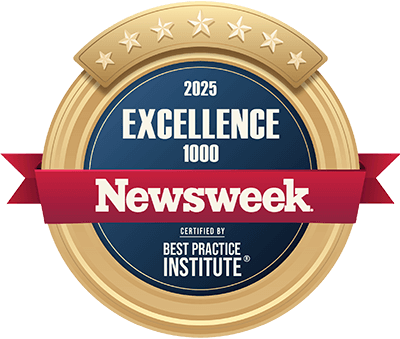Business Intelligence Implementation
Plan, Software, Costs, and Required Skills
ScienceSoft has been providing a full range of BI services, including consulting, implementation, support, and BI as a service since 2005.
Business Intelligence (BI) Implementation: Summary
Business intelligence implementation allows analyzing company’s data to support decision-making at strategic, tactical and operational levels.
Based on ScienceSoft's experience with real-life projects, BI implementation may take from 6 months and cost from $80,000, requiring a team of a PM, a BA, a solution architect, a BI developer, a data engineer, QA and DevOps engineers. Use our online calculator to get a ballpark cost estimate for your case.
Business Intelligence Implementation Steps
Each business intelligence implementation project is unique in its requirements, and a set of steps depends on its scale and specificity. Based on our experience in delivering business intelligence solutions since 2005, we outline some general steps that are typical of most projects.
Key steps to business intelligence implementation
- Conduct feasibility study.
- Gather requirements.
- Conceptualize and select platform.
- Plan the project.
- Develop the solution.
- Train users.
- Launch the project.
- Support and evolve the solution.
Sample project scope
- Business domain: Market analysis, financial analytics.
- Data sources: 2 big data sources (data in the data sources has clear mapping rules, so no data cleaning is needed).
- Storage layer: Data warehouse (cloud deployment).
- Analytics layer: an OLAP cube (a multidimensional dataset for online analytical processing).
- Data output layer: Power BI reports and dashboards (dashboard levels: CEO, department, personal).
- Data security model: Role-based security model.
1.
Feasibility study
We start by analyzing your business objectives, KPIs, existing data landscape, and current analytics maturity. A feasibility study allows us to estimate BI implementation costs, evaluate ROI potential, and identify the fastest paths to business value.
By the end of this stage, you get a clear business case for BI implementation, a risk–benefit analysis, and a roadmap showing how the BI solution will support strategic decision-making.
2.
Requirements engineering
Defining functional and non-functional requirements for a BI solution. These requirements can be further classified into two groups – mandatory and optional.
During the requirements engineering step, our BI consultants interview all stakeholders to collect their needs, goals, and vision of the successful BI project implementation. It helps understand their priorities, plan the development process accordingly and as a result - provide a satisfactory end product.
3.
Conceptualization and platform selection
- Defining the desired BI solution features, technology stack and skills required to fulfill the project.
- Mapping the proposed solution to the requirements.
- Defining data sources and ETL procedures, data quality assurance processes, business intelligence implementation and user adoption strategies.
As a result, the project team draws up the solution architecture with a detailed feature list.
To avoid unnecessary expenses at the development stage, we build the processes of conceptualization and platform selection on the established iterative communication among a BI analyst, a technical team and business stakeholders.
4.
Project planning
Defining deliverables, assessing risks, estimating BI implementation costs, TCO and ROI. After fulfilling this step, you get a detailed project plan, a project schedule and a communication plan.
Our practice has shown that effective BI implementation project planning can help reduce project time and budget by up to 30%.
5.
Development
- Delivering the back end and the front end of the BI solution.
- Implementing ETL processes for each of the data sources, setting up data quality management and data security.
- Running quality assurance procedures to avoid such problems as wrongly calculated KPIs, slow BI solution response or low-quality UX.
To deliver a BI solution in the shortest time possible, in our projects we opt for DevOps-driven iterative development – it assures the quickness and frequency of releases without sacrificing the solution’s quality.
6.
User training
- Providing end users with user manuals and training sessions.
- Adjusting common workflows for each user group, etc.
To ensure valid user screens, we schedule manuals creation after the development step is finished.
7.
Launch
- Pre-launch user acceptance testing to check the BI solution in real-world scenarios.
- Deploying the solution in production, ready for end users to employ.
Depending on the number of users, our BI team may use a phased approach to solution launch, according to which we release reports and dashboards to different user groups one by one over time.
8.
Solution support and evolution
Once your BI solution is live, we provide continuous monitoring, optimization, and technical support to ensure reliable performance and user adoption. Beyond maintenance, we evolve the platform to match your growing needs (from adding new data sources and self-service BI capabilities to embedding advanced analytics, predictive modeling, or data science features).
This ensures your investment scales with your business: the solution adapts to new markets, regulations, and business models, while continuing to generate actionable insights.
Consider Professional Services for BI Implementation
ScienceSoft offers 20 years of expertise in BI implementation services, delivering cost-effective business intelligence solutions tailored to meet both your short- and long-term business needs.
BI consulting
- Feasibility study.
- Solution concept.
- Business analysis.
- Launch strategy.
- Optimal sourcing model.
- BI software selection.
BI implementation
- Analyzing your BI needs.
- Developing a BI solution's components.
- Setting up ETL processes.
- Designing reports and dashboards.
- Adding data science capabilities, if needed.
- Conducting data management activities.
- Running quality assurance procedures, etc.
ScienceSoft as a Trusted BI Consulting and Development Partner:
When we first contacted ScienceSoft, we needed expert advice on the creation of the centralized analytical solution to achieve company-wide transparent analytics and reporting.
The system created by ScienceSoft automates data integration from different sources, invoice generation, and provides visibility into the invoicing process. We have already engaged ScienceSoft in supporting the solution and would definitely consider ScienceSoft as an IT vendor in the future.
Heather Owen Nigl, Chief Financial Officer, Alta Resources
Why ScienceSoft
Our awards, certifications, and partnerships
ScienceSoft's Team to Implement a BI Solution
Project manager
– manages scoping, planning, executing, and monitoring all aspects of the BI implementation project.
Business analyst
– interprets business needs, spells out the BI solution requirements, BI solution functionality, user roles, content and modules, integrations of the future BI solution.
Solution architect
– models BI infrastructure components (DWH, ETL processes, BI reports, etc.) and their integration points, ensures design feasibility.
Business intelligence developer
– develops a data model, sets up ETL processes, implements and maintains data modeling tools, query tools, data visualization and dashboarding tools, ad hoc reporting tools, etc.
Data engineer
– transforms data into a format suitable for analysis by analyzing raw data, developing and maintaining datasets, improving data quality and efficiency.
Quality assurance engineer
– validates the BI solution: designs and implements a test strategy, a test plan and test cases for BI components, validates SQL queries related to test cases and produces test summary reports.
DevOps engineer
– sets up the BI software development infrastructure, automates and streamlines development and release processes by introducing CI/CD pipelines, monitors system security, performance, and availability, etc.
The sample BI implementation project involving building a DWH, an OLAP cube, custom-built reports and dashboards would require the following team composition:
Feasibility study – project planning stages
- Project manager – 1 FTE*
- Solution architect – 1 FTE
- Business analyst – 2 FTE
- Data engineer – 0.5 FTE
- Business intelligence developer – 0.5 FTE
- Quality assurance engineer – 0.5 FTE
- DevOps engineer – 1 FTE
Development – user training stages
- Project manager – 0.5 FTE
- Solution architect – 0.5 FTE
- Business analyst – 1 FTE
- Data engineer – 2 FTE
- Business intelligence developer – 1-2 FTE
- Quality assurance engineer – 2 FTE
- DevOps engineer – 0.25 FTE
Launch stage
- Project manager – 1 FTE
- Business analyst – 0.5 FTE
- Data engineer – 1 FTE
- Business intelligence developer – 1 FTE
- Quality assurance engineer – 1 FTE
- DevOps engineer – 1 FTE
*FTE – full-time equivalent (8 hours/day).
Business Intelligence Implementation Sourcing Models
All in-house
The company has full control over the BI implementation project.
Caution: The implementation project can be delayed or compromised due to the lack of the required resources.
Technical activities are partially outsourced
Hiring a vendor to outsource the design, implementation or support of the BI solution. The model presupposes your high control over the implementation project.
Caution: High requirement for in-house competencies.
Technical activities are fully outsourced
Among the major pros – no risk of the resource overprovisioning after the project completion.
Caution: High requirements for in-house PM and BA competencies.
Everything is outsourced, except a project sponsor
This model promises no idle costs and no delays due to resource unavailability.
Caution: Increased vendor risks due to increased vendor dependency.
Benefits of BI Implementation with ScienceSoft
ScienceSoft's #1 priority is to achieve project goals regardless of time and budget constraints, as well as changing requirements. Check our project management practices that we've polished for 36 years and implement to guarantee project success no matter what.
BI services from A to Z
With our 20 years of experience in BI, we are eager to design, implement and support your BI solutions, as well as deliver related services such as data management, security, etc.
Full-fledged BI solutions
We build all the components of a BI solution: ETL/ELT processes, a data warehouse, a data lake, OLAP cubes, data visualization and reporting, as well as data science components (if any).
Proprietary BI framework
We have developed a BI framework to help companies monitor their activities, identify issues and their root causes, check best- and worst-case scenarios and more.
BI Implementation Cost
The cost of a business intelligence implementation project may vary significantly from project to project. We present the major cost factors:
- Number of data sources (ERP, CRM, HRM, EHR, ecommerce software, etc.).
- Data volume.
- Number of data tables and columns used for analysis.
- Complexity of data cleansing procedures.
- Types of analytics required, presence and number of machine learning algorithms.
- Number and complexity of reports (including ad hoc reports).
- Number of dashboards.
- User permission system complexity.
- Whether big data is to be analyzed.

The cost of a business intelligence implementation project (including a data warehouse, OLAP cubes, reports, and dashboards) can range from $80,000 to $1,000,000 depending on the system complexity and the company size.
Need to estimate your BI implementation project?
About ScienceSoft
ScienceSoft is a global IT consulting and IT service company headquartered in McKinney, TX, US. Since 2005, we’ve been providing our clients with BI services, including BI consulting, implementation, supporting and upgrading a BI solution, or getting regular data analysis and reporting on a subscription-fee basis. Being ISO 9001 and ISO 27001-certified, we rely on a mature quality management system and guarantee cooperation with us does not pose any risks to our clients’ data security.














